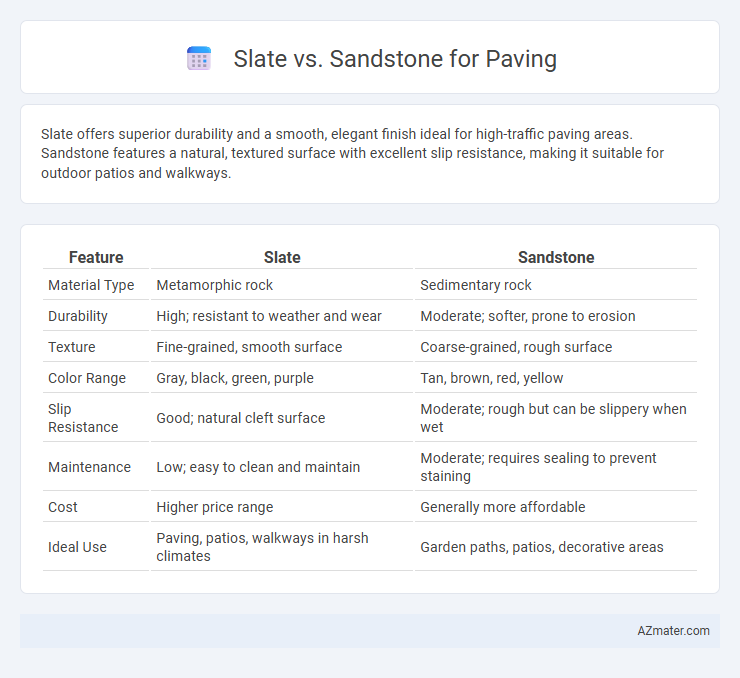Slate offers superior durability and a smooth, elegant finish ideal for high-traffic paving areas. Sandstone features a natural, textured surface with excellent slip resistance, making it suitable for outdoor patios and walkways.
Table of Comparison
| Feature | Slate | Sandstone |
|---|---|---|
| Material Type | Metamorphic rock | Sedimentary rock |
| Durability | High; resistant to weather and wear | Moderate; softer, prone to erosion |
| Texture | Fine-grained, smooth surface | Coarse-grained, rough surface |
| Color Range | Gray, black, green, purple | Tan, brown, red, yellow |
| Slip Resistance | Good; natural cleft surface | Moderate; rough but can be slippery when wet |
| Maintenance | Low; easy to clean and maintain | Moderate; requires sealing to prevent staining |
| Cost | Higher price range | Generally more affordable |
| Ideal Use | Paving, patios, walkways in harsh climates | Garden paths, patios, decorative areas |
Introduction to Slate and Sandstone Paving
Slate and sandstone are two popular natural stones used for paving due to their durability and aesthetic appeal. Slate is a fine-grained metamorphic rock known for its smooth texture and varying shades of gray, blue, green, and purple, offering a sleek and elegant finish for pathways and patios. Sandstone, a sedimentary rock composed mainly of quartz and feldspar, provides a more textured surface with warm earthy tones such as red, yellow, and brown, making it ideal for rustic and natural-looking paving designs.
Key Differences Between Slate and Sandstone
Slate features a fine-grained, foliated texture derived from metamorphic processes, offering higher durability and a smooth, natural cleft surface ideal for paving. Sandstone, formed from compacted sand grains, exhibits a coarser, grainy texture with softer mineral composition, making it more porous and prone to weathering over time. Key differences include slate's superior resistance to water absorption and frost damage compared to sandstone, which often requires sealing and maintenance to preserve its appearance and structural integrity in outdoor paving applications.
Appearance and Aesthetic Appeal
Slate offers a smooth, fine-grained texture with rich, deep hues ranging from dark gray to green and purple, creating a sophisticated and elegant look for paved surfaces. Sandstone features a more granular texture with warm, earthy tones like tan, red, and yellow, imparting a natural, rustic charm that enhances outdoor spaces. Both materials provide unique aesthetic appeal, with slate leaning towards modern refinement and sandstone evoking timeless, organic beauty.
Durability and Longevity
Slate offers superior durability and longevity compared to sandstone due to its dense, fine-grained structure that resists weathering and wear. Sandstone is more porous and softer, making it prone to erosion, chipping, and staining over time, especially in high-traffic or wet environments. Choosing slate for paving ensures a longer-lasting surface with lower maintenance requirements, ideal for both residential and commercial applications.
Slip Resistance and Surface Texture
Slate offers excellent slip resistance due to its natural cleft surface, making it ideal for outdoor paving in wet conditions. Sandstone features a coarser texture with a granular surface that provides good grip but may wear smoother over time, reducing slip resistance. Choosing between slate and sandstone depends on the desired balance between aesthetic texture and long-term traction on paving surfaces.
Weather Resistance and Climate Suitability
Slate offers superior weather resistance due to its dense, non-porous structure, making it ideal for wet and freeze-thaw climates where durability against water infiltration and cracking is crucial. Sandstone, while attractive for its natural texture, is more porous and susceptible to erosion and staining, requiring sealing in regions with heavy rainfall or extreme temperature fluctuations. Choosing slate ensures longevity in harsh weather conditions, whereas sandstone better suits mild, dry climates with minimal freeze exposure.
Installation and Maintenance Requirements
Slate paving requires precise installation to accommodate its natural cleft surface and prevent uneven laying, often needing professional expertise for optimal results. Maintenance for slate involves regular sealing to preserve its color and protect against moisture penetration, ensuring long-term durability. Sandstone paving is generally easier to install due to its more uniform texture but demands consistent cleaning to avoid staining and frequent resealing to maintain its resistance to weathering.
Cost Comparison: Slate vs Sandstone
Slate paving typically costs between $10 to $30 per square foot, reflecting its durability and natural cleft surface, while sandstone ranges from $6 to $15 per square foot, offering a more budget-friendly option with softer textures. Installation expenses for slate are generally higher due to its weight and cutting difficulty, potentially increasing total project costs by 15-25% compared to sandstone. Maintenance and longevity factors also impact overall cost-effectiveness; slate's superior resistance to weathering often leads to lower long-term upkeep compared to the more porous sandstone.
Eco-Friendliness and Sustainability
Slate offers eco-friendliness through its natural durability and low maintenance requirements, reducing the need for frequent replacement and conserving resources over time. Sandstone, sourced from abundant deposits, is biodegradable and permeable, promoting groundwater recharge and minimizing runoff, which enhances environmental sustainability. Both materials provide sustainable paving options, but sandstone's porous nature often makes it a better choice for eco-conscious landscaping projects aiming to support natural water cycles.
Best Applications for Slate and Sandstone Paving
Slate offers exceptional durability and slip resistance, making it ideal for high-traffic outdoor paving areas such as patios, walkways, and driveways. Sandstone features a natural, porous texture that provides excellent drainage, perfect for garden paths and pool surrounds where water runoff is a consideration. Both materials complement different landscaping aesthetics, with slate lending a sleek, modern look and sandstone enhancing rustic or natural designs.

Infographic: Slate vs Sandstone for Paving
 azmater.com
azmater.com